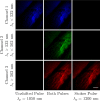Synchronously pumped Raman laser for simultaneous degenerate and nondegenerate two-photon microscopy
- PMID: 33996243
- PMCID: PMC8086478
- DOI: 10.1364/BOE.421647
Synchronously pumped Raman laser for simultaneous degenerate and nondegenerate two-photon microscopy
Abstract
Two-photon fluorescence microscopy is a nonlinear imaging modality frequently used in deep-tissue imaging applications. A tunable-wavelength multicolor short-pulse source is usually required to excite fluorophores with a wide range of excitation wavelengths. This need is most typically met by solid-state lasers, which are bulky, expensive, and complicated systems. Here, we demonstrate a compact, robust fiber system that generates naturally synchronized femtosecond pulses at 1050 nm and 1200 nm by using a combination of gain-managed and Raman amplification. We image the brain of a mouse and view the blood vessels, neurons, and other cell-like structures using simultaneous degenerate and nondegenerate excitation.
© 2021 Optical Society of America under the terms of the OSA Open Access Publishing Agreement.
Conflict of interest statement
The authors declare that there are no conflicts of interest related to this article.
Figures







Similar articles
-
Two-color multiphoton in vivo imaging with a femtosecond diamond Raman laser.Light Sci Appl. 2017;6(11):e17095-. doi: 10.1038/lsa.2017.95. Epub 2017 Nov 17. Light Sci Appl. 2017. PMID: 29576887 Free PMC article.
-
Two-Color, Two-Photon Imaging at Long Excitation Wavelengths Using a Diamond Raman Laser.Microsc Microanal. 2016 Aug;22(4):803-7. doi: 10.1017/S143192761601151X. Epub 2016 Aug 5. Microsc Microanal. 2016. PMID: 27492283
-
Single-laser-based simultaneous four-wavelength excitation source for femtosecond two-photon fluorescence microscopy.Biomed Opt Express. 2021 Jul 6;12(8):4661-4679. doi: 10.1364/BOE.428771. eCollection 2021 Aug 1. Biomed Opt Express. 2021. PMID: 34513216 Free PMC article.
-
Two-photon excited fluorescence enhancement with broadband versus tunable femtosecond laser pulse excitation.J Biomed Opt. 2012 Feb;17(2):025003. doi: 10.1117/1.JBO.17.2.025003. J Biomed Opt. 2012. PMID: 22463029
-
Two-photon excitation of fluorescence for three-dimensional optical imaging of biological structures.J Photochem Photobiol B. 2000 Mar;55(1):1-8. doi: 10.1016/s1011-1344(00)00028-2. J Photochem Photobiol B. 2000. PMID: 10877060 Review.
Cited by
-
SLAM medical imaging enabled by pre-chirp and gain jointly managed Yb-fiber laser.Biomed Opt Express. 2024 Jan 22;15(2):911-923. doi: 10.1364/BOE.506915. eCollection 2024 Feb 1. Biomed Opt Express. 2024. PMID: 38404349 Free PMC article.
-
Evaluation of a gain-managed nonlinear fiber amplifier for multiphoton microscopy.Biomed Opt Express. 2023 Apr 26;14(5):2324-2332. doi: 10.1364/BOE.485226. eCollection 2023 May 1. Biomed Opt Express. 2023. PMID: 37206123 Free PMC article.
-
From Research to Diagnostic Application of Raman Spectroscopy in Neurosciences: Past and Perspectives.Free Neuropathol. 2022 Aug 5;3:19. doi: 10.17879/freeneuropathology-2022-4210. eCollection 2022 Jan. Free Neuropathol. 2022. PMID: 37284145 Free PMC article.
-
Circumscribing Laser Cuts Attenuate Seizure Propagation in a Mouse Model of Focal Epilepsy.Adv Sci (Weinh). 2024 Aug;11(29):e2300747. doi: 10.1002/advs.202300747. Epub 2024 May 29. Adv Sci (Weinh). 2024. PMID: 38810146 Free PMC article.
References
-
- Rakhymzhan A., Leben R., Zimmermann H., Günther R., Mex P., Reismann D., Ulbricht C., Acs A., Brandt A. U., Lindquist R. L., Winkler T. H., Hauser A. E., Niesner R. A., “Synergistic strategy for multicolor two-photon microscopy: application to the analysis of germinal center reactions in vivo,” Sci. Rep. 7(1), 7101 (2017).10.1038/s41598-017-07165-0 - DOI - PMC - PubMed
Grants and funding
LinkOut - more resources
Full Text Sources
Other Literature Sources
Miscellaneous
